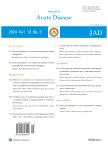Conversion disorder in a neurological emergency department:Restrospective series
Conversion disorder in a neurological emergency department:Restrospective series作者机构:Emergency Medicine PhysicianEmergency DepartmentInstituto Neurologico de Colombia General physicianEmergency Department Instituto Neurologico de Colombia Emergency Medicine ResidentUniversidad CES Research and TeachingInstituto Neurologico de Colombia
出 版 物:《Journal of Acute Disease》 (急性病杂志(英文版))
年 卷 期:2017年第6卷第5期
页 面:218-221页
学科分类:1002[医学-临床医学] 100214[医学-肿瘤学] 10[医学]
主 题:Conversion disorder Neurological symptoms Clinical
摘 要:Objective: To observe the conversion disorder in a neurological emergency department. Methods: It is common that the initial approach to this patients include the use of various diagnostic exams. In this series we reviewed 94 patients that arrived a neurological emergency room in a 3 year period. Results: 72 patients were females (76%), and the initial presumptive diagnosis were: neurovascular syndrome in 36 patients (38.3%), convulsive disorder in 20 patients (21.28%), and conversive disorder in 8 patients (8.51%). 82 patients had motor symptoms and 61 sensitive symptoms. 88 patients (93%) required neuroimaging studies, 77 (81%) patients underwent through basic biochemical panels. Other tests performed were:electroencephalogram in 12 patients (12.77%), electromyography in 11 patients (11.7%), lumbar punction in 8 patients (8.04%) and regarding the medical consult in the care of these patients 11 were evaluated by 1 specialists, 35 (37.2%) by 2 different specialties, 42 (44.63%) patients required evaluation by 3, and 6 patients (6.38%) required evaluation by 4 different specialties. Conclusions: Based on this data, we conclude that conversion disorders require a lot of resources in the emergency room and that the similarities with neurological diseases demands a complete workup including expensive diagnostic tools. However, this patients can be discharged safely without requiring hospitalization.



